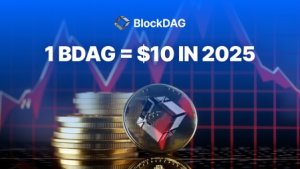Here we go! It’s the TULIP thing all over again!
A very incisive insight into how the various ‘manias’ of the past have ended up, which demonstrate the current crypto-mania and its evident pitfalls. London-based analytics expert Brad Alexander explains in a very charismatic and candid manner indeed

London-based Brad Alexander is CEO of FXLarge, www.fxlarge.com, a content provider whose clients are retail forex brokers and educators who are looking for the best way to motivate, educate and inspire their clients to trade better and with more confidence. The company provides bespoke and White Label educational and how-to videos and a twice weekly market update with trading ideas and timely commentary.
A long standing executive in the retail trading sector, Brad was originally fascinated by fundamental analysis from the age of 11 and started trading the Peseta before online trading became available. He has worked for brokers and technology providers and has a deep understanding of all sides of the industry.
When I was a kid, it seemed that the price of gold was always hovering around $40 per ounce (yes. I know. That was the 60’s. Please don’t do the math) Over the years the price crept up, slowly, to the point where it became an interesting vehicle for investment and a possible hedge against inflation.

The history books (or history web pages) talk about Gerald Ford’s allowing private ownership of gold, indecisive US Fed policies in the 70’s, and wild inflation under Jimmy Carter, which led to gold’s increasing prices.
What they don’t talk about is the frenzy, caused by the rapidly rising price of gold, at the end of 1979 into early 1980, where everybody just HAD to invest! The price would rise forever!
I remember seeing news stories on the television, showing queues of people buying gold at over $800 per ounce. These were innocent people investing their life savings, their children’s college funds, or their last pay check.
Unknowingly, they were participating in a trait of human nature which has been documented since the beginning of ancient commerce. They bought at the top of the market! As expected, the smart money did what they were supposed to do. They did their jobs. They sold.
(We didn’t use the word “bubble” in those days. A bubble was something you made while chewing gum or what little children made with soapy water.)
The price of gold crashed spectacularly leaving less than savvy investors with an asset worth a fraction of the price they paid for it. You might say, “Well, they at least had the gold.” True…but it took 30 years before the price came back.
We won’t make THAT mistake again!
At least gold is an substantive asset. If you are new to financial services you may not have heard about the first insane craze in a purely speculative market. Near the end of 1639, the prices of tulip bulbs…pretty ones, colorful ones, stripy ones…were escalating out of proportion.
By February of 1637 the bubble (or bulb-ble) had burst and scores of investors, horticulturalists and retail traders/gardeners were scratching their heads wondering why their multi-colored investment had gone to seed.
We won’t make THAT mistake again!
Moving ahead in time…1929.
Share prices were on the rise in breath-taking fashion. They would rise forever…they were rock solid investments!
During that year, two dollars out of every five dollars, loaned by banks, were used to invest in stocks. By September, 1929 the warning signs were there. Declining steel production, a severe drop in house building, and the failure of several banks were serious red flags.
However, as is typical when human beings get involved in a frenzy, all the warning signs were ignored and the crash at the end of October started the Great Depression and equities finally recovered to pre-depression levels in 1954!
Meanwhile, the repercussions of the 1929 Great Depression finally caught up with the rest of the world from 1933 to 1934 and the currencies of many countries were unpinned from the gold standard, just to survive.
Harsh economic conditions prevailed for years, with basic goods’ shortages and unemployment, forcing many societies to look at alternative political parties. …with Germany being an extreme example.
We won’t make THAT mistake again!
in 1996 it was clear that Alan Greenspan knew a thing or two about economics. Notwithstanding his long tenure as US Fed Chairman, there were not too many who didn’t know the name. His famous speech that year coined the phrase, “Irrational Exuberance”. He was referring, of course, to the mind-boggling amount of money being poured into the 90’s version of the tulip craze — the dot com era.
By 1998 market capitalisation, of many of these new companies, was reaching dizzying heights as anyone with an extra bit of disposable income was investing in anything that remotely smelled like “Internet”. Many of these companies actually had no assets but everyone knew they had “huge potential”.
Greenspan wasn’t the only expert warning us and, as usual, the experts were ignored.
Apart from the investors, talented people in finance, management, administration and marketing were lured into these companies, leaving good jobs, for “lots of potential” and inflated salaries.
On 10 March 2000, the NASDAQ peaked at 5048 then spent the next two and one-half years losing 78% of its value! This “5000” figure didn’t surface for air until 2015.
We won’t make THAT mistake again!
OK, hands up: Who has seen the film The Big Short? A better question then: Who HASN’T seen the film The Big Short?
Once in a while, the financial world just loves to chuck new words and phrases into the English language. The word “Sub-Prime” apparently existed in banks in 1978 but became a global buzz word when things started to go wrong in the late 2000’s.
In 2006, if you had asked an American 5-year-old child, “What do you want to be when you grow up?” the answer, “A mortgage broker” would not have been a huge shock.
Vast amounts of money were changing hands via mortgages, mortgage-backed derivatives, mortgage-backed bonds, mortgage-backed cat food futures, and a bizarre web of insurance policies and options. These were all designed to take advantage of a US housing market that, for all intents and purposes, would never stop rising. Ooops!
Even the American SEC, at the time, was warning us that much of these derivatives had less value than air but, if you were a Lehman Brothers executive, driving your Porsche up to the Hamptons on a sunny Friday afternoon, you really didn’t care.
The result was a complete melt-down of the global economy and a complete revamp of banking systems and policies around the world. Fortunately, we now have systems in place to ensure that:
We won’t make THAT mistake again!
Someone asked me, just two weeks ago, “Is this Bitcoin bubble dangerous? What happens if…?”
My response? I said, “Right now. No.”
“Apparently only 1000 people own about 40% of the Bitcoin assets (I’m playing fast and loose with the word “asset”) and it is only a tiny percentage of the economy.”
“The time to worry is when ordinary people start borrowing money or remortgaging their homes to buy Bitcoin. …and/or when lenders start lending money based on Bitcoin equity (I’m playing fast and loose with the word “equity”)”
Guess what’s happening now.
Will we see a time soon when this speculative vehicle (see how I avoided saying “asset”?) gets wrapped up in Bitcoin-based derivatives, Bitcoin-based bonds and Bitcoin-based cat food futures?
Don’t get me wrong. The underlying technology of crypto-currencies — blockchain — is awesome but, sadly, people seem to be getting the “currency” confused with the technology behind it.
When will the bubble burst? Who knows?
Worst case scenario? Who knows!
Best case scenario? David Fincher gets to make another feature-length film about the Winkelvoss twins.









